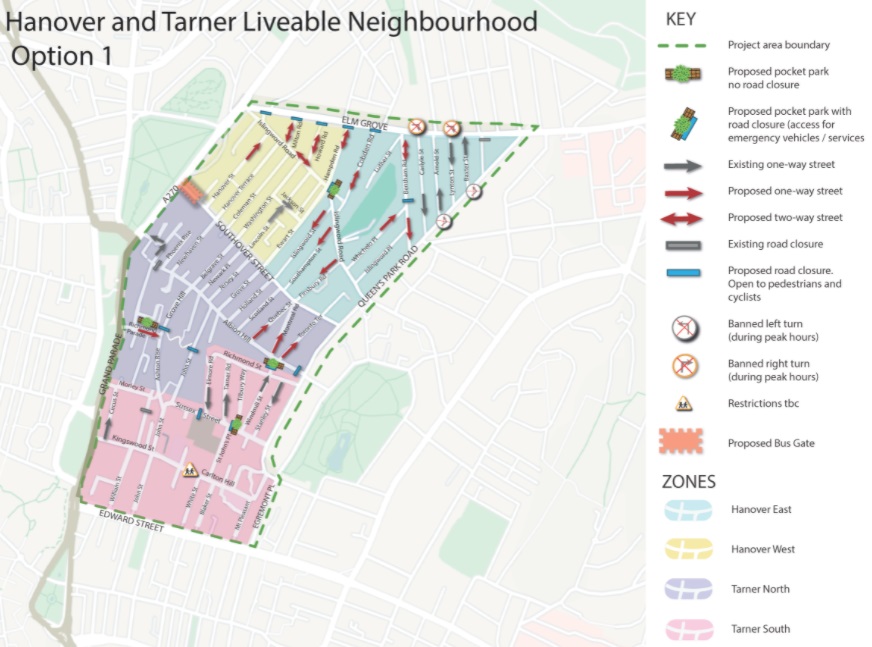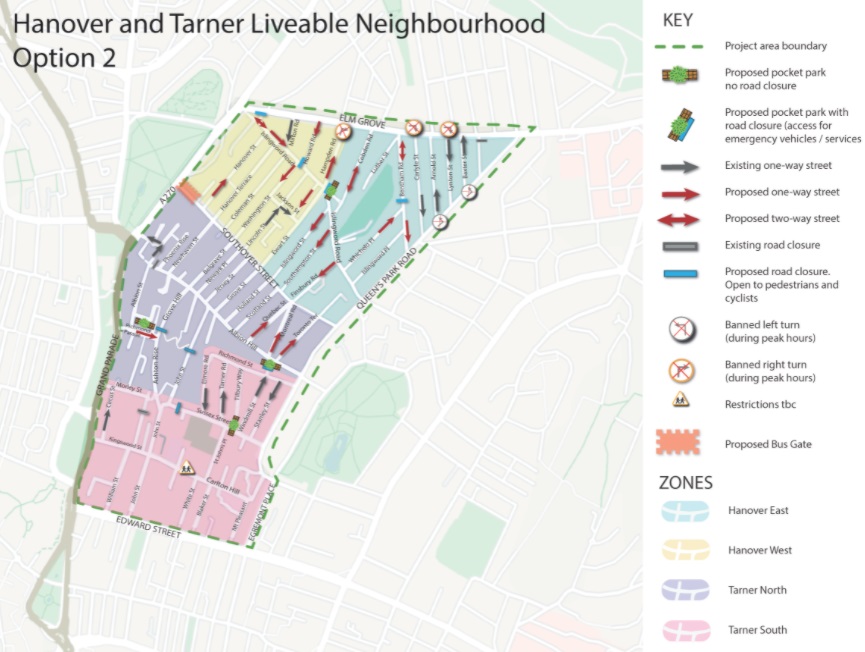
Road closures, one way streets, bus gates and pocket parks are options for Brighton’s first low traffic neighbourhood.
People living in Hanover and Tarner are being asked what they think of two possible options to cut down motor traffic in the neighbourhood.
Both options involve a road closure between Albion Rise and Grove Hill and a bus gate at the bottom of Southover Street, which would stop a lot of rat running.
Pocket parks would be dotted around, most also acting as traffic filters, and some roads turn from two-way to one-way or vice versa.
The only differences between the two schemes are the arrangement of one and two way streets and road closures in what the scheme refers to as Hanover east, the roads between Southover Street, Elm Grove, Lewes Road and Ewart Street/Hampden Road.

An online consultation and three community engagement workshops are taking place this month.
They are taking place at:
- Hanover Community Centre – Saturday 19 March, 10am – 1pm
- White Room, Phoenix Art Space – Tuesday 22 March, 3pm – 7pm
- The Barnard Community Centre – Thursday 24 March, 2pm – 6pm
Residents in the proposed Liveable Neighbourhood t area have all been sent information about the workshops in the post.
A full public consultation on the final design is scheduled to take place later this year.
Councillor Elaine Hills, member of the Environment, Transport and Sustainability committee and ward councillor for Hanover and Elm Grove said said: “We’ve already had some great ideas and comments from people in the Hanover and Tarner area.
“This is another opportunity for residents to get involved and help shape a project that will reduce traffic and create safer, more liveable space close to their homes.
“I’d urge everyone in the area to come along to the workshops or give their feedback online.
“I hope this will be the first of many Liveable Neighbourhood schemes in Brighton and Hove.
“They will be a key in helping to deliver safer streets, reduce carbon emissions, improve air quality and help us to become a Carbon Neutral city by 2030.”
The liveable neighbourhood pilot will create a low traffic neighbourhood which will be planned and designed to reduce motor traffic cutting through residential streets in the Hanover area.
Low traffic neighbourhood schemes minimise the amount of through traffic caused by drivers using residential streets to make short cuts to get to another destination.
It is important for destinations to be reached using the major road network wherever possible.
Schemes maintain access for private vehicles to homes and businesses within the area and enable priority access for emergency vehicles and council services such as waste collection and public transport.
Traffic is reduced by installing ‘filters’ such as bollards and planters and camera technology.









Evidence from other low traffic areas is that it displaces traffic to other areas. So yes, some privileged people will get less than their share of traffic but others will get more. The cunning thing is that, like controlled parking zones, only those in the area get asked. Those who will suffer don’t get a say
So if you live in an area just outside the zone, particularly on the main routes, you need to be heard.
This type of scheme needs to be looked at overall. Will it reduce pollution or just displace it? Will any displacement mean more miles travelled or congestion caused? If so, will this help B&H become carbon neutral or hinder it?
We also need to look at safety. Without through traffic areas become quieter. That’s the aim after all. But some areas in London have found that this has led to an increase in crime, particularly gangs. And led to people feeling less safe walking in the area. Oddly families shuttling their teenagers to the edge of the zone to where it was then busier and safer for them to walk!
As with many things, the devil is in the detail. We need to look at overall and ensure that both pollution and safety are not made worse by this.
How I wish we, as residents, would get a say. Judging by the plans we viewed this morning, we will have little say. We have option of two plans, both of which are utterly awful and will increase pollution.
The evidence is rising that all this does is push the problems elsewhere.
https://www.lbc.co.uk/news/council-apologises-ltns-increase-pollution/
This should be treated just as a trail initially whilst actual pollution is properly monitored both in the scheme and in the neighbouring areas.
I have walking difficulties but not a badge parking restrictions restrict my options for where I can go. Recently parking permits were introduced where I live and is causing me problems.
‘Liveable neighbourhood’? Surely that’s tautology?
Having lived in the Hanover area for thirty years I can tell you it’s already a neighbourhood, and doesn’t need the virtue signalling name.
The curious thing about these new proposals for road closures and extra one way streets is that they mean local residents have to take a longer route just to park outside their own homes. And so journey times are lengthened and traffic is increased.
If you live in Hanover you also know that you can walk into the city centre and nowadays you don’t get in a car or taxi unless you really need to. Let’s hope that those who can no longer manage the walk up the hill won’t get stranded in their own homes.
It’s not clear to me what the council are hoping to achieve here. You get the idea that some councillors won’t be happy until food is delivered by horse and cart. And yet in my lifetime, many of the local shops and pubs have closed down.
It looks like Islingword Road will be cut off. I make a trip to Archer’s coming in from Elm Grove and the returning out that way. My car is hardly inside the area.
I can’t make sense of these maps. It looks like a trip to the butcher or the shops at the lower end of Islingword Road will now cause a lot more driving through Hanover as “Hanover West” seems to be isolated from Elm Grove.
fake alternative choices: third way is keep it as it is instead of more profits to the companies that build the precious pocket parks ect
Roads are there to be used not close off by a council of car haters you say about rat runs since the bus lanes in the Lewes and London roads were introduced Woodingdean is like a motorway with non stop traffic most of the time
Great to see these plans on paper.
I don’t live in the area but Google frequently routes me through these residential streets instead of sticking to main roads.
I hope the residents take up this huge opportunity to improve their area and look forward to improved safety, more space for walking and cycling and better air quality that Livable Neighbourhoods deliver.
Who wouldn’t want improved safety and better air quality? Similar schemes in London haven’t delivered this – pollution outside a school went up by 44% (despite initial council claims that had reduced!)
The devil is in the detail. This is described as a trial. So let’s see the details of how the trial is to be measured. Where pollution and traffic monitors will be, both in the area and around it. Ditto on safety.
I can see through traffic in the area being reduced (well, actually displaced to longer routes). And I’ve also been routed that way by google, but ignored it as I prefer the larger routes around the area.
However, if the traffic in the zone is halved (which would be a great achievement) but local traffic to streets has to go twice as far to get to homes/work in the area then we’re back where we started for pollution. And worse overall for the city as the displaced through traffic is still there in streets around. Looking at the maps, double the distance for many of the local streets looks optimistic. Reaching some from anywhere but the east seems near impossible…
A suggested alternative option for the area. One which should cost less money and is proven to deliver results
Deliver on-street charging to every on-street parking space. Encourage local residents to switch to electric vehicles. Help with incentives where budgets allow.
Modern electric vehicles often have automatic collision prevention, so pedestrian and cyclist safety would also be improved too by enabling this switch
Low traffic neighbourhoods have good words but measurements from other areas show they aren’t delivering on what is promised. Many are making worse. So why not try something different, something proven to reduce fossil fuel usage and help whole neighbourhoods switch to electric vehicles? Surely that’s something worth trialling?
Not just EVs – my 2021 petrol ULEZ had collision prevention as well.
Need to focus electric power on higher mileage motorists where the payback is better and don’t forget the 50,000 mile carbon penalty for EV production vs. ICE and the probable need to upgrade power networks.
Would we need more street furniture outside every home to provide power to EVs?
Yes, I agree there are challenges. But that’s why a trial would be very useful – and something which would provide valuable lessons for the rest of the country. That’s why I’d hope a green council might be interested – demonstrate what is possible…
My view is that there would need to be something to plug into next to every over space – as the unit could provide power to a car on either side of it. The design of this furniture, whether it can be on/in the pavement, on a pole, across the pavement with covers over etc etc could (and should) all be part of a trial
In 20 years’ time, every street that doesn’t have private drives will need to be full of car charging points if we are to move away from ICE. How we get there is the key question
Councillor Elaine Hills states that it will reduce carbon emissions and improve air quality. Where is her proof? She has none! As others have stated, it will just cause more pollution to surrounding areas (I’m alright Jack). The implementation of the seafront cycle lane has increased congestion and pollution…FACT!
Why is our Council hell bent on spending time and money on these hair brain schemes which will inconvenience us all (not just car users). Get ready for mayhem when they replace the pier roundabout with traffic lights! Can’t wait😪
Does a certain councillor live in the area by any chance!
This is great!
Hanover already has many of these features so it’s just an extension.
Thankfully the powers that be can see the benefits from other countries and cities that have been doing this for a long time.
The comments on here are expected and sad. But you are the merely the death throes of an age soon to be history.
What is going to be consigned to history? Personal transport? I suspect not – think cycling, cars etc will remain. People didn’t like lockdowns and don’t see that returning by choice….
Do you mean the end of fossil fuels? If so, this scheme doesn’t help. There is nothing in this that helps that much needed move. Where are all the charging points?
If the aim is less use of personal transport and more public transport then again, that is missing. There doesn’t seem to be any plans for more services, more routes, better pricing or anything to encourage that.